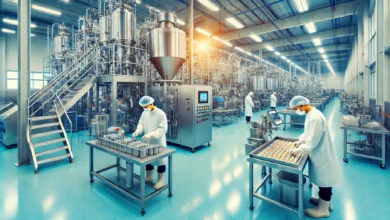How 3D Printing is Revolutionizing Manufacturing in 2024
Introduction to 3D Printing in Manufacturing
In 2024, 3D printing is no longer a novelty or an experimental technology—it’s a game-changer for global manufacturing. As industries increasingly adopt 3D printing, the potential for innovation, cost reduction, and sustainability has never been greater. But what exactly makes 3D printing such a transformative force in the manufacturing sector? How has it evolved, and what can we expect moving forward? This article delves deep into these questions, exploring how 3D printing is revolutionizing manufacturing in 2024 and beyond.
A Brief History of 3D Printing Technology
3D printing, also known as additive manufacturing, first emerged in the 1980s. At its core, the process involves building objects layer by layer from digital designs. Initially, it was used primarily for prototyping due to the high costs and limited capabilities. Fast forward to the 2010s, and the technology began to mature, becoming more accessible to different industries. By 2024, 3D printing has transformed into a vital tool in manufacturing, facilitating more flexible and efficient production.
The Evolution of 3D Printing in the Last Decade
Over the past decade, we’ve seen a steady refinement of 3D printing technologies. From improvements in printing speed and material variety to greater affordability, the technology has matured into an essential manufacturing tool. Today, businesses are using it not just for prototyping but for full-scale production, allowing for greater innovation and efficiency.
The Key Technologies Behind 3D Printing
Additive Manufacturing vs. Traditional Manufacturing
Traditional manufacturing relies on subtractive methods—cutting, drilling, and milling materials into desired shapes. In contrast, additive manufacturing builds objects layer by layer, minimizing material waste. This key distinction gives 3D printing its edge in industries where reducing waste and maximizing design flexibility are crucial.
Types of 3D Printing Technologies Used in Manufacturing
Several distinct 3D printing technologies are now common in manufacturing. Each has its unique advantages, depending on the materials used and the desired final product.
Fused Deposition Modeling (FDM)
FDM is one of the most widely used 3D printing techniques. It works by extruding thermoplastic filament, which is melted and deposited layer by layer. FDM is known for being cost-effective and is popular in industries where low-cost prototypes or functional parts are required.
Stereolithography (SLA)
SLA involves using a laser to cure liquid resin into solid shapes. Known for its high resolution and smooth surface finishes, SLA is ideal for creating intricate parts, such as dental models or jewelry prototypes.
Selective Laser Sintering (SLS)
SLS uses a laser to sinter powdered material, bonding the particles together to form a solid structure. SLS is commonly used in industrial settings where durable, high-performance parts are needed.
Direct Metal Laser Sintering (DMLS)
DMLS is the go-to method for 3D printing metal parts. It fuses metal powder into solid objects, making it a favorite in aerospace and automotive industries, where strength and precision are critical.
Benefits of 3D Printing in Manufacturing
The reasons for the widespread adoption of 3D printing in manufacturing are clear. Let’s take a closer look at some of the most impactful benefits.
Rapid Prototyping and Product Development
One of the earliest and most important applications of 3D printing is rapid prototyping. With traditional manufacturing, creating prototypes can take weeks, but with 3D printing, you can have a working model in a matter of hours. This speed allows companies to test designs quickly and iterate more efficiently, reducing the time it takes to bring new products to market.
Reducing Material Waste
Traditional manufacturing often results in significant material waste due to its subtractive nature. However, 3D printing’s additive process only uses the material required to build the object, leading to less waste and a more sustainable manufacturing process.
Customization and Design Flexibility
3D printing allows for unprecedented levels of customization. Unlike traditional methods that rely on molds and mass production, additive manufacturing enables manufacturers to create unique, one-off items without expensive tooling changes. This flexibility is particularly valuable in industries like healthcare, where customized medical devices can greatly improve patient outcomes.
Cost Efficiency for Low-Volume Production
While traditional manufacturing requires large-scale production to be cost-effective, 3D printing excels in low-volume manufacturing. For companies producing limited runs or specialized components, 3D printing eliminates the need for expensive molds and setup, making small-batch production much more feasible and affordable.
3D Printing and Sustainability in Manufacturing
Sustainability is becoming an increasingly important concern for manufacturers. The good news is that 3D printing offers several key environmental benefits.
Environmental Benefits of Additive Manufacturing
Using Recyclable Materials
Many 3D printers can now use recyclable materials, further reducing the environmental impact of manufacturing. Biodegradable plastics and recyclable metals are commonly used in 3D printing, contributing to a more sustainable production cycle.
Energy Efficiency in Production
Compared to traditional manufacturing, 3D printing often requires less energy. The streamlined nature of additive manufacturing, which eliminates multiple stages of production, contributes to greater overall energy efficiency.
Circular Economy Potential with 3D Printing
A circular economy is one where resources are reused and recycled, and 3D printing has the potential to play a crucial role in this shift. Since 3D printing allows for the precise use of materials and the recycling of waste, it aligns perfectly with the goals of a circular economy.
The Role of 3D Printing in Supply Chain Optimization
Beyond individual benefits in production, 3D printing is also reshaping how companies manage their supply chains.
Localized Production and Reducing Shipping Costs
3D printing enables localized production, which means companies can print parts or products closer to their end users. This reduces the need for long shipping distances and cuts down on transportation-related emissions and costs.
Just-in-Time Manufacturing
The ability to produce parts on demand means that companies can embrace just-in-time manufacturing, minimizing the need for large inventories. This results in lower storage costs and reduces the risk of overproduction.
Inventory Reduction and On-Demand Production
With 3D printing, manufacturers no longer need to stockpile large quantities of parts. Instead, they can print parts as needed, reducing excess inventory and associated costs while offering greater flexibility in responding to market demands.
3D Printing’s Impact on Different Sectors of Manufacturing
Different industries have embraced 3D printing for various reasons, but the impact is being felt across the board.
Aerospace and Automotive Manufacturing
In aerospace and automotive industries, 3D printing is used to create lightweight components that reduce fuel consumption without sacrificing strength. The ability to produce complex geometries also opens up new possibilities in design, allowing engineers to optimize parts for performance and efficiency.
Healthcare and Medical Device Production
The healthcare sector is one of the most exciting areas for 3D printing. From prosthetics to surgical instruments, the ability to customize and produce medical devices tailored to individual patients’ needs is transforming patient care. In 2024, 3D printing continues to push boundaries with bioprinting, creating tissue and even organs for medical research and future transplantation.
Consumer Goods and Electronics
3D printing has also made inroads in consumer goods, enabling manufacturers to create products that are highly personalized. In electronics, it’s being used to prototype circuit boards and even manufacture components for consumer devices.
Construction and Architecture
In construction, 3D printing is gaining attention for its ability to quickly produce building materials and even entire structures. By automating the construction process, companies can build faster and more sustainably, reducing both labor and material costs.
Challenges and Limitations of 3D Printing in 2024
While 3D printing offers many advantages, it is not without its challenges. Several key obstacles remain in the way of its broader adoption.
Material Limitations
Although the range of materials available for 3D printing has grown significantly, there are still limitations, particularly in terms of material strength and durability. For certain applications, traditional manufacturing techniques are still superior.
High Costs for Large-Scale Production
While 3D printing is cost-effective for low-volume production, scaling it up for mass production can still be expensive. The cost of printers, materials, and the time it takes to print large quantities remain significant barriers to wider adoption.
Regulatory and Quality Control Issues
The regulatory landscape for 3D-printed products, especially in industries like healthcare and aerospace, can be complicated. Ensuring that 3D-printed parts meet quality and safety standards is an ongoing challenge that manufacturers need to address.
3D Printing and Industry 4.0
3D printing is a key player in the broader Industry 4.0 movement, which is characterized by smart, automated, and data-driven manufacturing.
Integrating 3D Printing with AI and IoT
The integration of artificial intelligence (AI) and the Internet of Things (IoT) with 3D printing is enabling smart manufacturing processes. AI can help optimize designs, predict maintenance needs for 3D printers, and improve overall efficiency. IoT devices, meanwhile, provide real-time data that manufacturers can use to monitor and control the 3D printing process remotely.
Automation and Smart Manufacturing
3D printing is increasingly being automated, allowing for continuous production without human intervention. Combined with other Industry 4.0 technologies like robotics and AI, this automation is paving the way for fully smart manufacturing systems.
The Future of 3D Printing in Manufacturing
Innovations on the Horizon in 3D Printing Technologies
As we look to the future, 3D printing technology continues to evolve at a rapid pace. Advances in multi-material printing, faster printing speeds, and new materials such as graphene are set to further revolutionize manufacturing.
The Rise of 4D Printing and Its Implications
While 3D printing has already made a massive impact, 4D printing—where printed objects can change shape or function over time—promises to take it even further. 4D printing could open up new possibilities in areas like medical devices, aerospace, and robotics.
Predicting the Role of 3D Printing in Global Manufacturing by 2030
By 2030, we can expect 3D printing to play an even larger role in global manufacturing. With ongoing innovations and decreasing costs, it’s likely that more industries will adopt 3D printing for both prototyping and large-scale production. The potential for reshoring manufacturing, improving sustainability, and enabling rapid innovation will likely make 3D printing a cornerstone of future manufacturing strategies.
3D Printing for Small Businesses and Startups
Democratizing Manufacturing with Affordable 3D Printing
One of the most exciting aspects of 3D printing is how it’s democratizing manufacturing. Small businesses and startups that previously couldn’t afford the expensive equipment and tooling needed for production now have access to affordable 3D printers, allowing them to compete with larger companies.
Case Studies of Small-Scale Manufacturing Successes
Across various industries, we’ve seen small businesses leverage 3D printing to create niche products, from custom footwear to unique consumer electronics. These companies have been able to thrive by offering personalized, small-batch products that traditional manufacturing couldn’t support.
The Role of 3D Printing in Education and Skill Development
As 3D printing becomes more prevalent, there is a growing need for education and skill development.
Preparing the Workforce for 3D Printing
Training the next generation of engineers, designers, and technicians to use 3D printing technologies is crucial for the future of manufacturing. Many educational institutions are already incorporating 3D printing into their curriculums to prepare students for the jobs of tomorrow.
Universities and Vocational Training in Additive Manufacturing
In addition to formal education, vocational training programs are offering hands-on experience with 3D printing technologies. This ensures that workers are equipped with the skills they need to thrive in a manufacturing landscape increasingly dominated by 3D printing.
Overcoming Barriers to Widespread Adoption of 3D Printing
Despite the many advantages of 3D printing, there are still barriers to its widespread adoption.
Bridging the Knowledge Gap
One of the main challenges is the knowledge gap between those who are familiar with 3D printing technologies and those who aren’t. Educating more manufacturers about the benefits and applications of 3D printing is essential for its broader adoption.
Addressing Intellectual Property Concerns
As with any new technology, 3D printing raises concerns about intellectual property (IP). With the ability to easily replicate designs, manufacturers and designers are concerned about protecting their innovations. Addressing these IP issues will be key to ensuring the responsible growth of 3D printing.
Building Global Collaboration for Additive Manufacturing Standards
Creating global standards for 3D printing will be essential for ensuring consistent quality and safety. By working together, industries can develop standards that enable the widespread adoption of 3D printing while maintaining high levels of quality control.
Conclusion
In 2024, 3D printing is poised to further revolutionize the manufacturing landscape. From rapid prototyping to reducing waste and enhancing customization, it offers a wealth of benefits that are transforming industries worldwide. While challenges like material limitations and high costs for large-scale production remain, the future of 3D printing is bright. As the technology continues to evolve and become more accessible, it will reshape how products are designed, produced, and delivered—paving the way for a more sustainable, innovative, and efficient manufacturing ecosystem.



